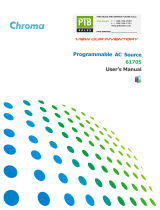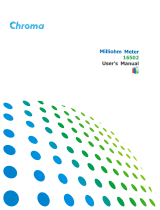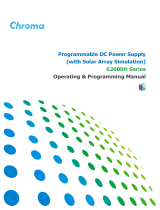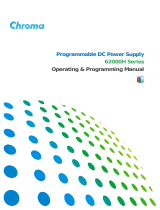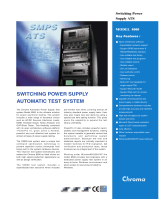
Programmable AC Source 61501/61502/61503/61504 User’s Manual
xi
Table of Contents
1. General Information ................................................................................................1-1
1.1 Introduction............................................................................................................1-1
1.2 Key Features.........................................................................................................1-1
1.3 Specifications ........................................................................................................1-1
1.4 Names of Parts......................................................................................................1-3
1.4.1 Front Panel ................................................................................................1-3
1.4.2 Rear Panel.................................................................................................1-5
2. Installation................................................................................................................2-1
2.1 Inspection..............................................................................................................2-1
2.2 Preparation for the Use .........................................................................................2-1
2.3 Requirements of Input Power................................................................................2-1
2.3.1 Ratings.......................................................................................................2-1
2.3.2 Input Connection........................................................................................2-1
2.4 Output Connection.................................................................................................2-3
2.5 Remote Sense Connection....................................................................................2-3
2.6 Procedures of Power-on........................................................................................2-4
2.7 I/O Connectors (Option) ........................................................................................2-5
3. Local Operation.......................................................................................................3-1
3.1 Introduction............................................................................................................3-1
3.2 Operation through Keypad and RPG.....................................................................3-1
3.3 MAIN PAGE (Output Setting and Measurement) ..................................................3-4
3.4 CHOICE PAGE (Functional List Choice)...............................................................3-5
3.5 SETUP Functional List ..........................................................................................3-5
3.5.1 RANGE......................................................................................................3-6
3.5.2 Vac LIMIT...................................................................................................3-7
3.5.3 Vdc LIMIT (+), Vdc LIMIT (-)......................................................................3-7
3.5.4 I LIMIT, DELAY..........................................................................................3-8
3.5.5 OUTPUT RELAY .......................................................................................3-9
3.5.6 BUZZER.....................................................................................................3-9
3.5.7 DATALOCK................................................................................................3-9
3.5.8 Is START, Is INTERVAL..........................................................................3-10
3.6 CONF Functional List..........................................................................................3-10
3.6.1 REMOTE INHIBIT....................................................................................3-11
3.6.2 EXT. V, COUPLE.....................................................................................3-12
3.6.3 WAVEFORM GENERATOR....................................................................3-13
3.6.4 POWER ON STATUS..............................................................................3-14
3.6.5 GPIB Address, RS-232C .........................................................................3-15
3.7 OUTPUT Functional List......................................................................................3-15
3.7.1 COUPLE Mode of Output (AC+DC, AC, DC) ..........................................3-16
3.7.2 OUTPUT DEGREE..................................................................................3-18
3.7.3 Programmable Output Impedance...........................................................3-18
3.7.4 Slew Rate of Output Transient.................................................................3-19
3.7.5 HIGH VOLTAGE OPTION.......................................................................3-20
3.7.6 THREE PHASE MODE............................................................................3-21
3.7.7 PARALLEL MODE...................................................................................3-23
3.8 Save and Recall ..................................................................................................3-25
3.8.1 Save and Recall Output Setting...............................................................3-25
3.8.2 Save and Recall System Data.................................................................3-27
3.9 Protection ............................................................................................................3-28
4. Calibration................................................................................................................4-1




















